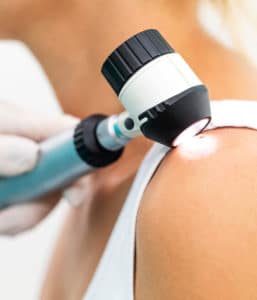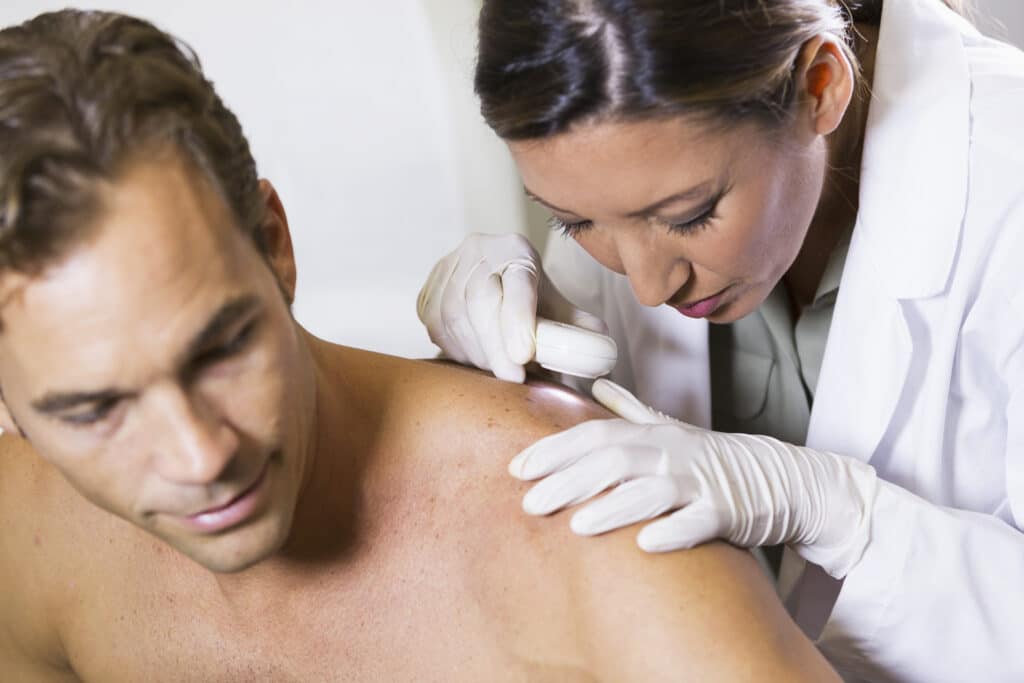Skin Cancer Surgery New York City
Skin Cancer Surgery
Despite the fact that most of us no longer slather on baby oil in the quest for the deepest tan, skin cancer rates in the United States continue to climb. Basically one in five of us will develop at least one form of skin cancer in our lives. Much of this could be due to early sun damage in people now in their 50s and older before sunscreens were very effective or available, and before the damage being caused by the sun was fully understood.
Regardless, skin cancer is now the most common cancer in the U.S.
The key to successful treatment of skin cancer is an early diagnosis. When skin cancers are detected early, the success rates are very high. This is particularly true with melanoma, the most dangerous form. The problem is that many people don’t have their skin regularly screened for skin cancer, and that’s dangerous. Point in fact, the American Cancer Society estimates that one million Americans are living with untreated melanoma.
At Laser & Mohs Dermatology of New York, we provide skin cancer screening and treatment for the various forms of skin cancer. Dr. Quintana is the vice president of Skin Cancer Foundation. The Skin Cancer Foundation is the only international organization devoted solely to education, prevention, early detection, and prompt treatment of the worlds most common cancer.
What is Skin Cancer?
Skin cancer is simply a mutation of normal skin cells into cancerous cells. The sun’s ultraviolet rays alter the genetic material in the skin cells, causing the mutation. Skin cancer can develop on areas that don’t receive any sun, but this is rarer.
Whether you’re prone to developing skin cancer or not can depend on the amount of melanin in your skin. Melanin is what gives our skin its pigment, and it provides protection from sun damage to the cells. This is why our skin tans in response to UV radiation: the melanin turns the skin a darker tone as a protection mechanism.
Fair-skinned people have less melanin in their skin, so they are more apt to develop skin cancer with sun exposure. Research shows that about half of all fair-skinned people who live to be at least 65 years old will develop at least one skin cancer in their lifetime.
What Are The Different Types of Skin Cancer?
Skin cancer begins in the epidermis, the skin’s top layer. The epidermis contains three main types of cells: squamous cells that lie just below the outer surface, basal cells beneath the squamous cells, and melanocytes in the lower part of the epidermis. The common forms of skin cancer get their names from the cell types. Here are their descriptions and what they look like.
Basal Cell Carcinoma
Eighty percent of skin cancers are basal cell carcinomas. These cancers usually develop on sun-exposed areas, especially the head and neck. They tend to grow slowly and rarely spread to other parts of the body. Diagnosing and removing basal cell skin cancer is not usually difficult. But if left untreated, basal cell carcinomas can grow into nearby areas and invade bone or other tissues beneath the skin, making removal potentially disfiguring.
Basal cell carcinomas look like a flesh-colored, pearl-like bump or pinkish patch of skin.
Squamous Cell Carcinoma
Squamous cell carcinoma accounts for roughly one-fifth of all skin cancers. Squamous cell cancers appear on sun-exposed areas of the body such as the face, ears, neck, lips, and backs of the hands. They are more likely to spread to other parts of the body than basal cell cancers, but this is still rare.
Squamous cell carcinomas will look like a red firm bump, scaly patch, or a sore that heals and then re-opens.
Melanoma
This deadliest form of skin cancer is also, fortunately, the rarest. But, unlike basal and squamous cell cancers, melanomas are far more likely to grow and spread if left untreated. When melanomas grow downward, they can begin to deposit cancerous cells into the bloodstream, which can then spread the cancer anywhere in the body.
A melanoma will suddenly appear as a new dark spot on the skin. They will also show as a change in the size, shape, color, or elevation of an existing mole. This is more typical in people with over 50 moles. With melanoma, you can follow the ABCDE warning signs:
-
- Asymmetry — If one half of the mole doesn’t match the other half, that’s a concern. Normal moles are symmetrical.
- Border — If the border or edges of your mole are ragged, blurred, or irregular, it should be checked.
- Color — Normal moles are a single shade throughout. If your mole has changed color or if it has different shades of tan, brown, black, blue, white, or red, then it should be checked.
- Diameter — If a mole is larger than the eraser of a pencil, it needs to be checked.
- Evolving — If a mole evolves by shrinking, growing larger, changing color, itching or bleeding, or other changes, it should be checked. Melanoma lesions often grow in size or gain height rapidly.
Importance of Skin Cancer Checks
Skin cancer is very prevalent, but early detection makes it relatively easy to remove and treat. Checking your own skin is important, looking for the descriptions noted above with the various forms of cancer. But even more important are yearly skin cancer checks. These are a good idea for anyone who is over 40 or has had extensive sun exposure over their lifetime.
At Laser & Mohs Dermatology of New York, we offer the most advanced screening methods for early detection of skin cancer. Plus, with advanced treatments like our Skin Cancer surgery, the success rates are incredibly high.
But we can’t spot and treat your skin cancer if you don’t come in for regular skin cancer checks.
What To Expect During A Skin Cancer Exam
Before you come in to see Dr. Quintana, it’s a good idea to look over your skin yourself. Check every part of your skin, including your scalp, behind your ears, even under your arms. Look for any moles or growths that are new, have changed shape or color, bleed regularly, or itch.
Your screening at our Manhattan offices will usually take around 10 minutes, longer if we spot anything of concern. You’ll get undressed and will put on a medical exam gown, as your entire body needs to be checked. This includes between your toes and the soles of your feet.
Dr. Quintana is looking for the signs described above. They also are checking for actinic keratoses, pre-cancerous skin changes that can turn into cancer down the road.
Treatments For Skin Cancer
During your exam if we spot a growth that we suspect of being skin cancer, we will biopsy the growth. We numb the area with a small dose of local anesthetic and then scrape off as much of the mole as possible with a tool called a curette for small growths, a scalpel for larger growths. We then send the tissue to the lab to test for cancer.These are the typical methods for removing or addressing skin cancers.
- Cryosurgery — The growth is frozen with liquid nitrogen. The frozen cells crust and scab and then fall off within a couple of weeks.
- Electrodesiccation — This uses an electrocautery needle to burn and destroy the cancerous cells.
- Excision — For small growths, the curette basically scoops out the growth. For larger growths, a scalpel is used to surgically excise the growth, along with some surrounding border tissue as a safety margin.




